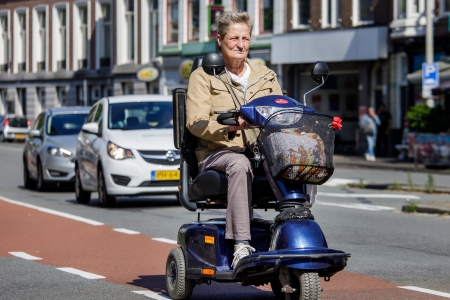Mobility scooter users are virtually unprotected, and the crashworthiness of enclosed disability vehicles and microcars is also much worse than that of cars. This implies that, in case of a collision with another vehicle or an obstacle, or in case of a single-vehicle crash, the users of these vehicles run a higher risk of getting (seriously) injured. Their injury risk is often even higher due to their age or medical ailments. Therefore, a fall or collision often results in more serious physical consequences than would be the case for a younger, healthier person.
In addition to their limited crashworthiness, mobility scooters, enclosed disability vehicles and microcars also contribute to speed and mass differences between vehicles on the road. Because of the Sustainable Safety principle ‘(bio)mechanics’ this diversity is undesirable. Also see SWOV fact sheet Sustainable Road Safety.
Mobility scooters
As far as we know, there are no studies that have specifically looked into the ‘crashworthiness’ of mobility scooters. It can, however, be discussed in terms of general principles. Mobility scooter users are unprotected, like cyclists or light moped riders for example. They are not protected by the body of their vehicle. Like cyclists and light moped riders in the Netherlands, they are not obliged to wear a helmet either. In case of a collision, they therefore run a higher risk of (serious) injury than road users driving a heavier and shielded vehicle.
Enclosed disability vehicles and microcars
Compared to mobility scooters, the enclosed body of disability vehicles and microcars offers slightly more protection in case of a collision, but still much less than (small) cars. The results of EuroNCAP tests of several microcar models in 2014 en 2016 also clearly shows this [13]. The models scored poorly and were awarded only one out of five stars, due to their bodies having fewer crumple zones that can absorb the released collision energy. The potential for more vehicle body protection is limited since the weight of a microcar or enclosed disability vehicle may not exceed 350 kilos.
The low weight of a microcar has an additional disadvantage. When a lighter and a heavier vehicle collide, the occupants of the lighter vehicle are generally more seriously injured than the occupants of the heavier vehicle (also see SWOV fact sheet Speed and speed management ). Compared to car occupants, the microcar occupants are thus seriously disadvantaged. Moreover, especially outside the urban area, the speed of a microcar will differ greatly from that of other road users, which will result in the release of more energy in case of a collision, and therefore in more serious injuries.
Microcar occupants are obliged to wear seatbelts or helmets (in case of missing seatbelts). This does not apply to occupants of enclosed disability vehicles that normally do not have (properly functioning) airbags either.
